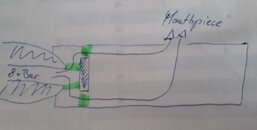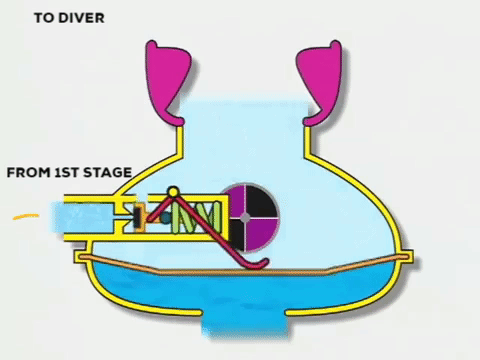phgachoud
Registered
Am doing my padi IDC and had a question (dont remember where...) about second stage reducing the IP to the ambiant pressure the diver needs... am really not understanding how that can be. From my understanding, correct me if I'm wrong.
On the attached picture, the maximum pressure is probably defined by widest space for the air to flow (in green above) is that what defines the maximum pressure a second stage can deliver and its proportional to the first stage pressure? if so are we talking about always a maximum of my above minimum column or more? Sorry might be redundant and hope you got my question and point...
- IP is around 8-9Bar + ambiant pressure 0m=8-9Bar + 1Bar | 10m=8-9Bar + 2Bar | ...
- Second stage open its valve on demand, meaning the more you suck the more it opens its valve pushing on the lever. So the maximum air pressure it can deliver is given by the surface of the biggest hole from the IP down to the mouthpiece right? it doesnt seem to me there are holes smaller into a hose down to a second stage making sure this pressure is never > 1Bar on ambiant pressure. So, one question would be, can a second stage deliver more than 1Bar on ambiant pressure or not, and if so why and how is it regulated so that you dont receive 9 bars on the mouth and if not how is this 1 bar limited??
- If I suck as hard as I can, how much pressure can I take from my second stage?
- Are we talking about demand valves because you'll regulate your pressure with the force you suck limiting the size of the hole between the pupet and the inlet cone?
| Depth (in m) | Absolute IP (Intermediate Pressure from First stage) in Bar | Second stage pressure minimum on mouthpiece in Bar | Second stage pressure maximum on mouthpiece in Bar |
|---|---|---|---|
| 0 | 8+1=9 | 1 | ? |
| 10 | 8+2=10 | 2 | ? |
| 20 | 8+3=11 | 3 | ? |
| 30 | 8+4=12 | 4 | ? |
On the attached picture, the maximum pressure is probably defined by widest space for the air to flow (in green above) is that what defines the maximum pressure a second stage can deliver and its proportional to the first stage pressure? if so are we talking about always a maximum of my above minimum column or more? Sorry might be redundant and hope you got my question and point...








